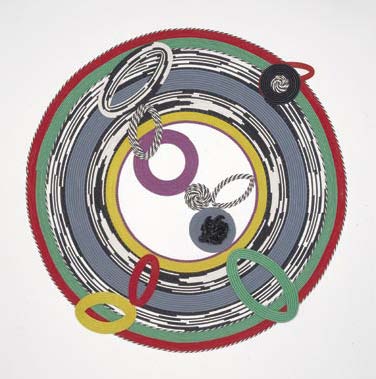JAY S. WILLIS
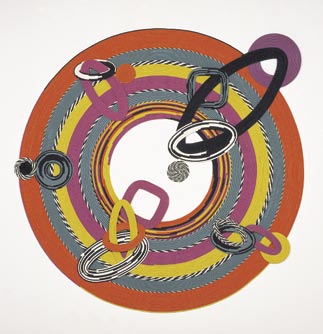
Dragon’s Gate, 2003, 1999, painted welt, 84 inches diameter
ESSAY BY DOUG MEYER
|
In using large, ringed circles as formats for wall sculpture Jay Willis has managed to fuse dramatic visual sensation with an Eastern aspect of meditative contemplation. His process of infusing upholster’s welt material with brilliantly-hued color then forming it into concentric bands up to eight feet in diameter entertain a decidedly non-Western methodology and reading. Willis has brought his fascination with the historical and cultural iconography of the circle and the maze together into a kind of new age constructivism. Up until 1998 Willis had created painted steel floor constructions in which he utilized a labyrinthine design conjuring up a broad range of cultural associations. In attacking the problem of moving his floor sculptures onto the wall Willis has been conscious of avoiding the rectangular and pictorial. He does not want his viewers to look into the pieces as if they were windows. Willis has always stringently avoided traditional referents that “mirror the vision of the world” in his work, feeling that abstractions based within the imagined grid of the rectangle confirm tired Western rationalizations of thought. It has been the intention of Jay Willis |
with his Hanging Garden Series to draw the viewer into the center of his whirling lines of multi-hued skeins of rope-like welt, only to find empty space in defiance of the Western notion of visual hierarchical design. Perhaps this is the closest Willis comes to Zen philosophy, his reference to nothingness as clarity. The empty space at the center of these wreath-like structures is without pretense. The center is a hole, around which revolve idiosyncratic segments of color shapes that tweak the radial symmetry of their composition. Willis’s use of color is both intuitive and rationalized. Bands of full-intensity fauve hues are punctuated by braided strands of black and white. The dazzling color is seductive but also forms a necessary link in a visual chain that alludes to its wholeness. Like a Tibetan mandala or a Zen garden the visual sensation of the parts is made meaningful only by connecting them to a state of harmonic oneness. With the insertion of smaller elliptical welt coils that intersect and project out from the wall Willis refers to the rocks, shrubs, and paths that interrupt Japanese Zen gardens, obstacles to take us away from our linear thinking as our minds analyze the structure of the designs. |
|
A circular format has been employed by such contemporary artists as Robert Irwin and Jasper Johns. Irwin’s seductively beautiful circular wall pieces represented an innovative presentation of form freed from its traditional constraints. He was entertaining one of Western art’s central preoccupations with perceptual illusion. Willis’ work assiduously avoids optical trickery in order to assert a non-representational veracity. What you see is what it is. While Jasper Johns’ circular Target paintings can be viewed as critiques of the concentric hierarchy of our male-dominant society Jay Willis’ Hanging Gardens offer, in turn, an alternative to Western relativism in their non-hierarchical compositions. There are no parts of these oversized wreaths that are more important than others. The viewer’s eye flows from one section to another in what seems like no particular order. Within the concentric design one notices the varied widths of color shapes distributed in no perceivable pattern except outward. The color intervals of painted welt grow exponentially outward from the center. Willis begins there, proceeding at times to evoke cultural associations with his color relationships. There are glimpses of the reds, blacks, yellow, and turquoise found in |
Navajo rugs. Several of these works begin with a squarish diamond shape in the center that almost imperceptibly changes into a circle on their outer perimeter. In one of these, Diamonds to Donuts (it’s all the same), the center appears to be the shape of a baseball field and the colors are reminiscent of a stadium seating chart. Diamond Lane evokes the frenetic energy of the L.A. freeways. Many of his elliptical overlapping shapes possess a feeling of freeway interchanges in their interlocking patterns of swirling energy.
The connection between a Zen garden, a stadium, and a freeway may be rather oblique, but these things reflects the esoteric fragmentary existence of contemporary life. In simpler times the Cubists drew upon diverse objects of everyday life to subvert narrative content. Jay Willis asks the viewer as well to judge his works in a narrative-free context in order to dash the preconceptions we have about what art should look like. He has cleverly fashioned a place between literal form and illusion in which visual seduction leads to quiet contemplation, like a walk in a beautiful garden where surprises await us with every turn in the path |
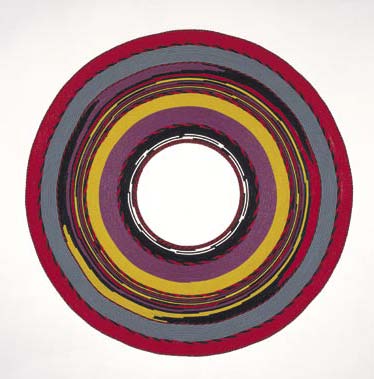
The Third Eye, 1999, painted welt, 95.5 inches diameter
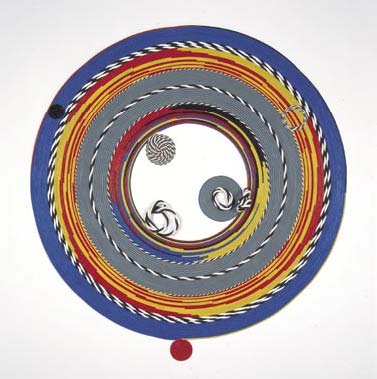
Present Tense, 2001, painted welt, 86.5 x 81 x 7 inches
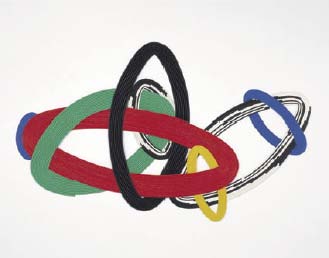
Merrill’s Garden, 2002, painted welt, 48 x 74 inches
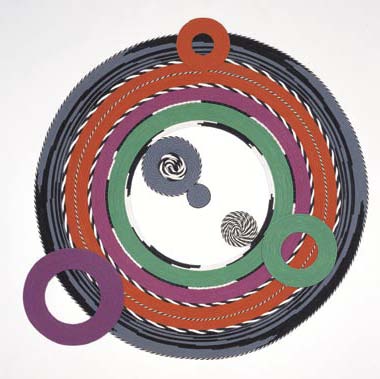
Wall Street Pond, 2001, painted welt, 74 x 75 x 3 inches
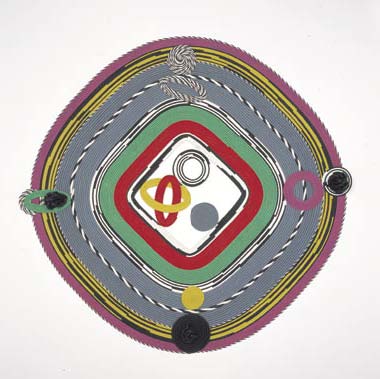
Western Landscape, 2002, painted welt, 73 x 77 x 6 inches
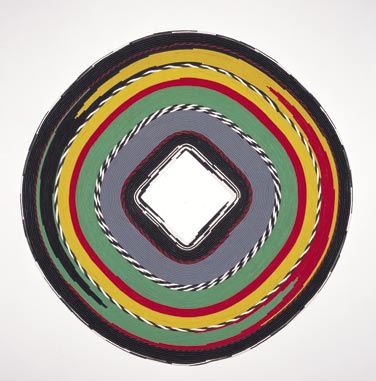
Diamonds to Donuts. It’s All the Same., 2000, painted welt, 91 inches diameter
| JAY S. WILLISBorn Fort Wayne, Indiana 1940
Residence Pasadena, California Education University of California-Berkeley, CA 1966 MA-sculpture University of Illinois, Champaign/Urbana, IL 1964 BFA-sculpture Selected Individual Exhibitions 2004 Robert V. Fullerton Art Museum, California State University-San Bernardino, San Bernardino, CA 2003 Double Vision Gallery, Los Angeles, CA. (catalog) 2003 California State University Fullerton, Grand Central Art Center, Project Room, Santa Ana, CA. 2000 Hyde Gallery, Grossmont College, El Cajon, CA 1999 Limn Art Gallery, San Francisco, CA 1999 Wylie and Mary Louis Jones Art Gallery, Bakersfield College, Bakersfield, CA 1991, 1988, 1986, 1985,1983, 1981, 1978, 1975, 1974 Cirrus Gallery, Los Angeles, CA 1984 Pima Community College, Tucson, AZ 1978 Fisher Art Gallery, University of Southern California, Los Angeles, CA (catalog) 1976 Orange Coast College, Costa Mesa, CA 1973 California State University, Fresno, CA Selected Group Exhibitions 2000 Cal State University- Fullerton, Newquist collection exhibition, Fullerton, CA 1996 Skirball Cultural Center, Hebrew Union College, Los Angeles, CA – “Blessing and Beginnings” 1995 Los Angeles County Museum of Art, Los Angeles, CA – Made in L.A., The Prints of Cirrus Editions” (catalogue) 1993 Olga Dollar Gallery, San Francisco, CA — “Miniatures” 1992 Gallery X, Exeter, England- “LA Abstract Artist” 1991 Olga Dollar Gallery, San Francisco, CA – “Seductive Geometry-8 LA Artists” 1989 National Peace Garden Design Competition, National Building Museum, Washington, D.C., Oct.- Nov. 1984 Chapman College, Orange, CA – “Chapman College Sculpture Acquisition Program” (catalogue) • Los Angeles County Museum of Art, Los Angeles, CA – “Olympic Project” • Design Center of Los Angeles, CA – “A Broad Spectrum: Contemporary LA Painters and Sculptors ‘84” (catalogue) 1983 Gensler and Associates, San Francisco, CA – “Series Two” |
Security Pacific National Bank Plaza, Los Angeles, CA – “Urban Sculpture/Architectural Concerns” (catalogue)• Baxter Art Gallery, California Institute of Technology, Pasadena, CA
• San Francisco International Airports Commission Exhibition, “Constructions”, 1982 Gensler & Associates/Architects, Century City, CA – “Architectural References • Los Angeles Municipal Art Gallery, Los Angeles, CA – “Painted Sculpture” • Fresno Art Center, Fresno, CA – “Forgotten Dimension – A Survey of Small Sculpture in California Now” (catalogue) 1981 Baxter Art Gallery, California Institute of Technology, Pasadena, CA “Anti- Static” 1979 Crocker Art Museum, Sacramento, CA – “Aspects of Abstract: Recent Painting and Sculpture” • Fisher Art Gallery, University of Southern California, Los Angeles, CA – “Persistence of Illusion” (catalogue) 1976 Capricorn Asunder Gallery, San Francisco, CA – “Los Angeles Video” 1975 Henri Gallery, Washington, DC – Group Exhibit • Newport Harbor Art Museum, Newport Beach, CA – “Four by Eight” • Los Angeles Institute of Contemporary Art, ABC Entertainment Center, Los Angeles, CA – “Current Concerns Part II” 1973 Texas Gallery, Houston, TX – “Southern California Artist” • La Jolla Museum of Contemporary Art, La Jolla, CA – “Wall Objects” Academics University of Southern California, Professor of Fine Arts-sculpture 1969-present Founding Director of Masters in Public Art Studies 1990-present Chair of Studio Arts 1988-1989 University of Arizona, Instructor-sculpture 1966-1969 Thanks! University of Southern California, School of Fine Arts, Faculty Development Fund for underwriting the catalog. Website: jaywillis.com E-mail: jwillis@usc.edu |
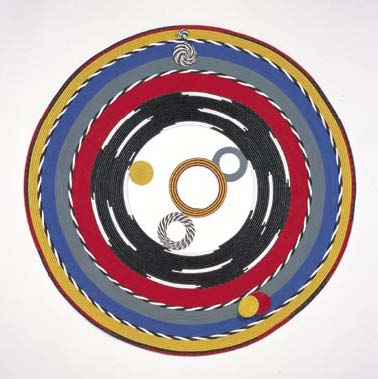
Secret Garden, 2000, painted welt, 79 inches diameter

